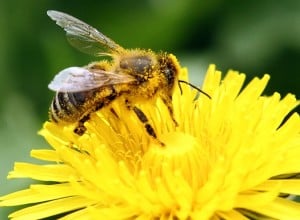There is no mystery about the disappearing bee. Pesticides have been the problem all along.
More Evidence Suggests Honeybees Are Dying en Masse Because of Pesticides
Danielle Wiener-Bronner REUTERS/Heinz-Peter Bader
REUTERS/Heinz-Peter Bader
The report, which appears today in the Bulletin of Insectology, recreates a 2012 study which first linked the bee-killing disease with neonicotinoids. The same team of researchers from the Harvard School of Public Health who conducted the 2012 study ran this later one, and their findings bolster their earlier findings. According to lead author Chensheng (Alex) Lu, “We demonstrated again in this study that neonicotinoids are highly likely to be responsible for triggering CCD in honey bee hives that were healthy prior to the arrival of winter.”
To perform the latest study, the researchers examined 18 bee colonies in three different locations in central Massachusetts. They split each colony into three groups — one treated with a neonicotinoid called imidacloprid, one with a neonicotinoid called clothianidin, and one left in pristine condition to serve as a control group. The scientists monitored the groups from October 2012 to April 2013 and found that, by the end of that period, half of the neonicotinoid colonies had been decimated, while only one of the control colonies was destroyed by a common intestinal parasite, Nosema cerenae. None of the bees were affected until winter, the authors write:
We found honey bee colonies in both control and neonicotinoid-treated groups progressed almost identically, and observed no acute morbidity or mortality in either group until the arrival of winter… As temperatures began to decrease in late October 2012, we observed a steady decrease of bee cluster size in both control and neonicotinoid-treated hives continued to decline.
The new study also offered some novel information. When the team conducted the research in 2012, a whopping 94 percent of infested colonies died off. The discrepancy suggests that the harsh winter of the period studied (2010-2011) likely exacerbated the effects of the insecticides.
Further, the study put to rest the notion that parasites are contributing to CCD. Discover explains:
When CCD first emerged in honeybee colonies in the mid 2000s, N. ceranae was put forward as a possible cause. Subsequent research in Europe, however, has suggested N. ceranae was widespread in many areas before CCD and is not associated with the phenomenon. Although other studies have suggested that pesticides, particularly neonicotinoids, cause bees to become more susceptible to mites or other parasites that then kill off the bees, today’s study found that bees in the CCD hives had the same levels of parasite infestation as the control colonies.
The loss of honeybees is concerning because they pollinate roughly one-third of all crops, globally, and up to 80 percent of U.S. crops. And this study is just a jumping off point. Says Lu, “future research could help elucidate the biological mechanism that is responsible for linking sub-lethal neonicotinoid exposures to CCD.” Here’s hoping.
